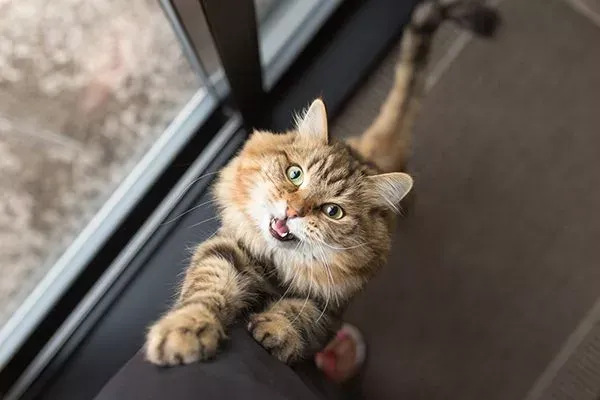If you’re wondering, “Why is my cat meowing excessively?” you’re not alone. Cats are naturally vocal pets, using meows, yowls, purrs, and hisses to communicate. However, when meowing becomes more frequent or intense than usual, it often signals an underlying issue. This guide explores the top six reasons for excessive cat meowing, helping cat owners identify causes and take appropriate action.
Excessive vocalization disrupts daily life and can indicate health or behavioral concerns. Understanding these triggers allows you to respond effectively, ensuring your feline companion stays happy and healthy.
 Cat meowing excessively
Cat meowing excessively
What Does Excessive Meowing in Cats Mean?
Excessive meowing varies by cat personality—some are chattier by nature. Generally, it’s excessive if it’s a sudden increase, persists during odd hours like nighttime, or interferes with your routine. For instance, a cat that only meows at mealtime might start yowling at 3 a.m., prompting concern.
Veterinarians define it as vocalization beyond normal patterns, often linked to needs, stress, or illness. Monitoring patterns helps differentiate routine chatter from problems.
Common Reasons for Excessive Cat Meowing
1. Seeking Attention or Affection
Many cats crave interaction despite their independent reputation. Boredom, loneliness, or under-stimulation leads to persistent meowing for pets, play, or cuddles. Indoor cats especially suffer if left alone too long.
Remedy this with daily play sessions using toys like feather wands or laser pointers. Interactive feeding puzzles also combat boredom. According to the ASPCA, regular engagement reduces attention-seeking vocalizations significantly.
2. Basic Needs: Hunger, Thirst, or Access
Cats meow to request food, fresh water, litter box access, or entry/exit from rooms. An empty bowl or dirty litter can trigger non-stop calls. Learned behavior reinforces this—cats realize meowing gets quick results.
Check bowls first: Ensure high-quality wet or dry food meets nutritional needs, like those recommended by the Association of American Feed Control Officials (AAFCO). Rotate flavors to prevent pickiness, and provide multiple water stations to encourage hydration.
3. Heat Cycles and Breeding Instincts
Unspayed females yowl loudly during estrus (heat), every 2-3 weeks, lasting up to a week. Males respond vocally to pheromones, pacing and meowing to locate mates. This instinctual drive peaks at night.
Spaying or neutering eliminates 90% of heat-related vocalizations, per the American Veterinary Medical Association (AVMA). Early sterilization also prevents cancers and roaming behaviors.
4. Stress or Environmental Changes
Major life events—new pets, moves, renovations, or family additions—stress cats, amplifying meows. Vet visits or fireworks trigger similar responses. Sensitive cats vocalize anxiety through yowls or chirps.
Minimize stress with pheromone diffusers like Feliway, stable routines, and safe hiding spots. Gradual introductions to changes help. Studies from the Journal of Feline Medicine and Surgery show these reduce stress-induced vocalizing.
5. Aging and Cognitive Decline
Senior cats (over 10 years) often meow excessively at night due to cognitive dysfunction syndrome (CDS), akin to human dementia. Vision/hearing loss, confusion, or sundowning causes disorientation, leading to wandering yowls.
Support with night lights, consistent furniture layouts, and antioxidant-rich senior diets. Routine vet checkups screen for CDS; medications like selegiline improve symptoms in 75% of cases, per veterinary research.
6. Medical Issues or Pain
Sudden excessive meowing warrants a vet visit, as it signals pain, hyperthyroidism, kidney disease, hypertension, or dental issues. Cats hide discomfort but vocalize when hunger/thirst intensifies from conditions like diabetes.
Symptoms include weight loss, increased drinking, or lethargy. Early diagnosis via bloodwork is crucial—kidney disease affects 30-50% of cats over 10, notes the International Cat Care organization.
How to Address Excessive Meowing in Cats
Respond by observing context: Time of day, body language, and recent changes guide solutions. Rule out medical causes first with a vet exam, including blood tests and urinalysis.
Implement preventive strategies:
- Enrich environment with scratching posts, perches, and toys.
- Feed scheduled meals to avoid demand meowing.
- Schedule regular wellness checks, especially for seniors.
Most cases resolve with lifestyle tweaks, but persistent issues need professional input. Tracking meows in a journal aids vets.
In summary, excessive cat meowing stems from attention needs, instincts, stress, age, or health woes. Proactive care—attention, spaying, vet visits—restores quiet. Consult your veterinarian for tailored advice, and explore more cat care tips on our site for healthier, happier pets.
References
- American Veterinary Medical Association (AVMA): avma.org
- ASPCA: aspca.org/pet-care/cat-care
- Journal of Feline Medicine and Surgery: Studies on feline stress and vocalization.
